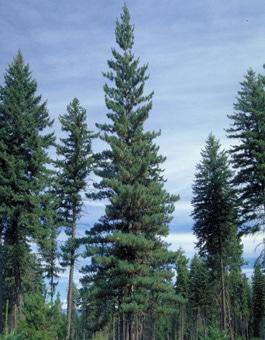

Strong and straight
The western white pine is prized as a commercial species because of a long straight trunk that runs free of branches for up to two-thirds of its length. Its wood is easily worked and is ideally suited for window and door frames, paneling, shelving and other structural applications.
Range
Its range extends south from British Columbia and from western Montana to northeastern Oregon, with a preference for deep, porous soils and gentle slopes.
Character
The western white pine grows rapidly, attaining heights of 175 feet and trunk diameters from 5 to 8 feet. It is easily identified by its stalked cones, which are slender, curved and grow from 5 to 15 inches long. Needles are 2 to 4 inches long and grow in clusters of five. White lines are on two sides of each needle. The bark of mature trees is brownish-gray, and is broken into small rectangular blocks.
Understory
On warmer sites you’ll find an understory of huckleberry oak, red huckleberry, pygmy Oregon grape, and box-leaved silk-tassel. On cooler sites, manzanita and western serviceberry occur frequently, with beargrass common to all sites.
Climate
The western white pine can occur in a variety of climates ranging from warm and wet to cool and dry. Average annual temperature ranges from 38˚F to 49˚ F and annual precipitation ranges from 45 to 130 inches.
Management
A disease called blister rust, a fungus that was imported in 1910 on French white pine ornamental shrubs, decimated the white pine. Over the years, forest geneticists wereable to develop a strain of western white pine that is resistant to blister rust. Today, reforestation efforts are underway but hampered by the presence of firs and other trees that took over the western white pine's range when this species died back.